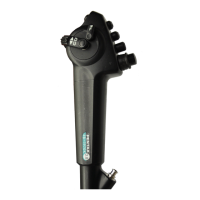– 26 –
1-2-3-7. Rinsing
WARNING
It is important that all internal channels, external endoscope surfaces,
and components be thoroughly rinsed with clean water to remove residual
detergent solution. Failure to do so can result in ineffective or incomplete
disinfection and sterilization.
First rinse
1) Place the endoscope with the inlet seal (OF-B190), and cleaning adapter (OF-B155)
attached in a basin of clean water that is of sufcient volume to completely immerse
the endoscope.
2) Detach inlet seal (OF-B190), and cleaning adapter (OF-B155) from the endoscope. Open
the cap of inlet seal (OF-B190). (Figure 1.18, p24)
3) Wipe all exterior surfaces of the endoscope, inlet seal (OF-B190), and cleaning adapter
(OF-B155) one time with a lint-free gauze in order to remove residual detergent solution.
4) While still completely immersed in water, grasp the distal end and control body of the
scope and PVE connector with two hands, and agitate them under the water by moving
them from side to side repeatedly for one minute.
Figure 1.20
5) Similarity, agitate inlet seal (OF-B190), and cleaning adapter (OF-B155) under the
water by moving them from side to side repeatedly for at least one minute.
6) Attach inlet seal (OF-B190), and cleaning adapter (OF-B155) to the endoscope.
(Figure 1.15, p23)
7) Attach a syringe lled with water to the suction nipple, and ush the suction channel
with 35 mL of water. (Figure 1.16, p23)
8) Insert a syringe filled with water into inlet seal (OF-B190), and flush the suction
channel with 35 mL of water. (Figure 1.17, p24)
9) Remove the endoscope with inlet seal (OF-B190), and cleaning adapter (OF-B155)
attached from the water.
10) Attach a syringe lled with air to the suction nipple, and ush the suction channel
with 35 mL of air to expel residual water. (Figure 1.16, p23)
11) Insert a syringe lled with air to the inlet seal, and ush the suction channel with 35
mL of air. (Figure 1.17, p24)
Endoscope
Cleaning
1

